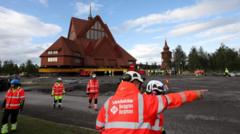As the air-conditioned bus weaves through the bustling traffic of Kolkata, tour leader Sujoy Sen lists heritage sites on the itinerary—the colonial General Post Office, Hindu and Jain temples, and the homes of freedom fighters. But this tour offers a unique experience: it unfolds after sundown and highlights the newly illuminated architecture of the city.
The Kolkata Illumination Project is a recent addition to the city's heritage tours, inspired by enthusiasts who aim to shed light on grand but neglected structures. Sujoy Sen was astonished at how beautiful night-time Kolkata could be, comparing it to the glimmer of Paris.
Himanjali Sankar, a participant born in Kolkata, expressed that the illuminated buildings seemed to embrace their historical splendor anew. The project stems from a citizens' group known as the Kolkata Restorers, propelled by individuals like Mudar Patherya, who is dedicated to reviving the city's luminous identity.
Patherya's initiative began with lighting up an old market’s dome, leading him to work on over 92 buildings across the city, including the iconic Raj Bhavan. The model he adopted is simple: property owners pay only for electricity while he organizes the illumination.
With enticing designs, expert lighting adjustments, and a sense of community pride, Kolkata is evolving its nighttime scenery. As the state of repair for many buildings became apparent, further efforts in restoration have emerged, including clock repairs on historic structures, such as those managed by fourth-generation clockmaker Swapan Dutta.
Ultimately, the Kolkata Restorers aim to restore not only buildings but a sense of pride in Kolkata. In a city rich with architectural history, the collective efforts underscore the importance of valuing and preserving heritage, against the backdrop of modern advancement.
Patherya aspires to illuminate even more landmarks and make Kolkata's architectural narrative a beacon of pride, revealing that the city's architectural past is as vital as its modern future.




















